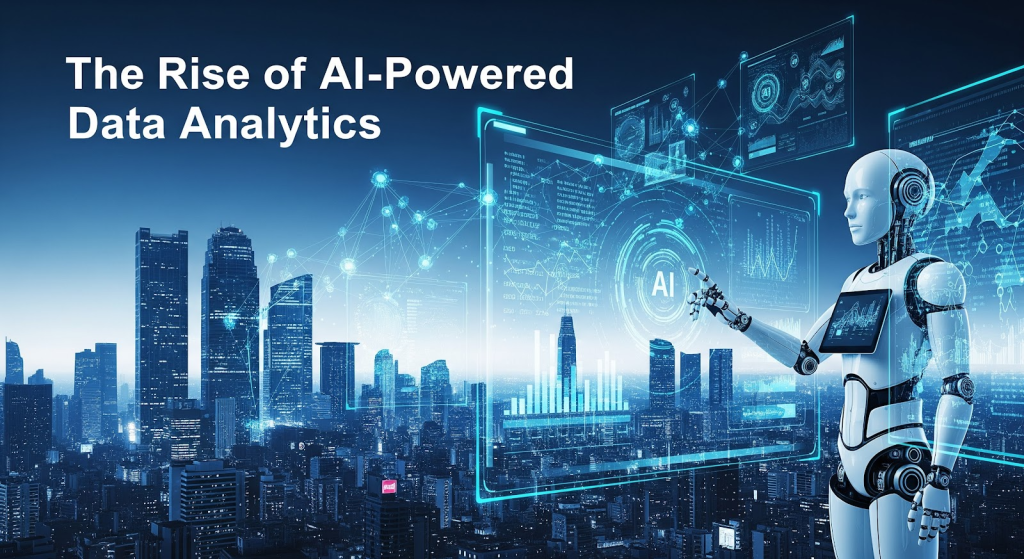
Every business today is swimming in data. Customer clicks, supply chain updates, IoT sensors, financial transactions—the volume is staggering. But here’s the real challenge: having more data doesn’t automatically mean having more insight.
For years, traditional analytics tools have helped teams answer the basics—what happened last quarter, which region sold the most, or where operations lagged. Useful, but ultimately backward-looking.
Now, with AI-powered analytics, the shift is dramatic. Instead of just reporting history, businesses can forecast demand, detect anomalies before they become risks, and even recommend the next best action—all in real time.
From Dashboards to Decisions
Traditional analytics revolved around descriptive insights. They told you what happened but rarely why it happened—or what to do next.
AI-powered analytics goes beyond:
- Predictive insights – forecasting trends, customer churn, or market demand with high accuracy.
- Prescriptive actions – recommending the “next best step” instead of leaving interpretation to human analysts.
- Automated intelligence – surfacing anomalies, detecting risks, or optimizing pricing in real time, without waiting for manual reporting.
The result? Businesses move from static dashboards to dynamic, decision-ready intelligence.
Key Drivers Behind the Rise
Several forces are converging to make AI analytics mainstream:
- Explosion of Data Sources: Every digital interaction—customer clicks, IoT devices, or logistics logs—creates data at a scale that humans alone cannot keep up with.
- Advances in Machine Learning & Generative AI: Modern models can recognize patterns across millions of variables, generate natural language summaries, and even explain complex correlations in plain English.
- Demand for Real-Time Decision-Making: Markets move in hours, not weeks. AI analytics allows businesses to react instantly, instead of waiting on monthly dashboards.
- Democratization of Analytics: With natural language querying (“Ask me in plain English”), insights are no longer locked with technical teams—they’re accessible to decision-makers across functions.
Real-World Impact Across Industries
The impact of AI analytics is already visible across industries:
- Retail & E-commerce: Personalized recommendations, smarter inventory management, and dynamic pricing that adapts in real time.
- Banking & Insurance: Fraud detection, credit risk scoring, and automated claims processing.
- Healthcare: Predicting patient readmissions, improving treatment plans, and accelerating drug discovery.
- Manufacturing: Predictive maintenance, supply chain risk analysis, and AI-powered quality control.
These aren’t just pilot programs—they are competitive differentiators separating leaders from laggards.
Challenges That Still Remain
Like any transformative technology, AI analytics comes with hurdles:
- Data quality & governance – Without clean, unbiased data, AI will amplify errors.
- Transparency – Leaders need explainability, not black-box predictions.
- Change management – Teams must learn to trust machine-assisted insights.
- Ethical considerations – Responsible AI practices must be embedded from the start.
Success lies not in technology alone, but in building trust and ensuring accountability.
The Future: AI as an Analytics Partner
Looking forward, AI won’t just power dashboards—it will become an active partner in decision-making.
- Conversational AI will answer complex business queries instantly.
- Context-aware assistants will surface risks before they escalate.
- Self-optimizing systems will learn continuously from new data streams.
In short, the future of analytics is not just smarter tools, but smarter decisions—made faster, and with greater confidence.
Conclusion
AI-powered data analytics isn’t just another technology upgrade—it’s a turning point in how businesses compete. The advantage no longer lies in collecting the most data, but in converting data into decisions at speed and scale.
Companies that embrace this shift will move from reacting to the past to proactively shaping the future. Those who hesitate risk being left with outdated insights in a real-time world.
At OpenTurf, we see AI analytics as a trusted partner—not a replacement for human judgment, but a catalyst for sharper, faster, and more confident decision-making.
Also read how observability is shaping the GenAI landscape, explore our blog on GenAI Observability Trends in 2025.
